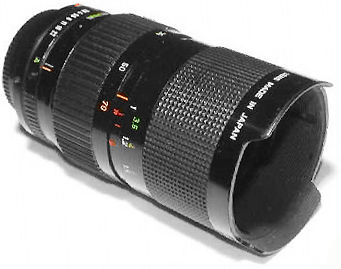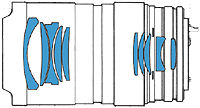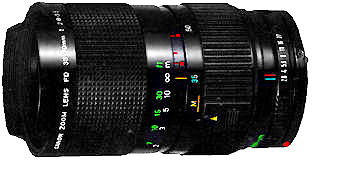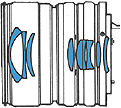35-70mm zoom lenses, often called standard zooms, are very popular. During the early to mid-eighties, Canon has even bundled their SLR with a compact version of this zoom to replace the traditional 50mm standard lens of either f/1.8 or f/1.4.
 |
The very first type of this zoom lens can be traced back to December 1973, where the high speed FD 35-70mm f2.8-3.5 was first brought to the photographic world. As far as the lens' zoom ratio relates, zoom range and as well as the basic spec has not been changed and remained in the FD lens series until the lenses were eventually 'phased out' and replaced with the new EF lenses in 1987. |
Although using a modern measurement, this lens falls short of everything, but in those days, it was an immensely popular unit. One of their major advantages is framing flexibility. The angle of view increases and perspective becomes increasingly stretched out when zooming back from the standard 50mm focal length towards the 35mm end. As you zoom from the 50 mm setting to the 70mm extremity, you will notice that blurs, rather than compressed perspective, become increasingly conspicuous. Zooming capability thus permits optimal framing, plus the choice of elongated or compressed perspective to suit the subject. What makes these zooms so handy is that they can be used in place of three fixed focal length lenses. However, as discussed earlier, zoom lenses are in most cases heavier than fixed focal length lenses, which reduces their convenience. The introduction of a lightweight, compact zoom lens has thus been a long sought-after goal. The FD 35-70mm f/3.5-4.5 zoom was introduced in late 1982 as the first of a new series of compact, plastic zoom lenses with a 'molded' lens barrel for reduced weight to supplement the 'new' T-series camera bodies. Depending on shooting requirements, you can choose between the FD 35-70mm f/2.8-3.5 and the FD 35-70mm f/3.5-4.5. If you place the highest priority on larger apertures, the former is best, but if portability and price is your major concern, the latter may be is the better choice.
See an older version of the Canon FD 35-70mm f/2.8~f/3.5 S.S.C. lense .. More info
 |
The once smallest manual focus zoom was incorporated with the world's first three groups system and 2 groups zoomimg system (PDF Illustration: 168k) Also Check Older Version of the FD 35-70mm f4.0 * Credit: Philip Chongfor providing the additional info |
The faster speed FD 35-70mm f/2.8-3.5 uses a two group zooming system which contributes to its relative compactness considering its large maximum aperture. Looking at the lens diagram, however, the FD 35-70mm f/3.5-4.5 zoom is even more compact; it seems to be about the same size as a fixed focal length lens. The compactness was very much due to a adopted zooming system which uses three lens groups. Much of a fruit of the research by computer simulations, the movement of the zooming system was reduced by dividing the rear lens group into two separate subgroups, one which moves and one which doesn't. |
 |
<<<-- Reluctant to be photographed, a local policeman who was on duty during the State Visit of Bill Clinton to China. |
|
|
In a 3 group system's operating principles, during zooming the moveable part of the rear lens group is only slightly displaced. The addition of the stationary element means that the rear group moves less than its counterpart in the 2 group system. This enables the lens to be much smaller. When compared to the FD 50mm f/1.2 standard lens, measuring 50.5mm in length and weighing 380g, the FD 35-70mm f/3.5-4.5, with a length of 60.9mm and a weight of a mere 200g, certainly seems compact and lightweight. It is as compact as fixed focal length lenses in many instances. |
Both of these lenses have macro functions. With the FD 35-70mm f/2.8-3.5 lens, macro photography is possible at the 35mm end at the short film to-subject distance of 30cm. However, there is lesser restriction on the compact zoom, the FDN 35-70mm f/3.5-4.5 MACRO SHOWN ABOVE offers macro capability over the whole focal length range. Before this compact zoom was made available, there was a Canon FD 35-70mm f4.0 version as well which also was very popular. This lens compromised a little in its lens speed but gained a lot in its physical dimension and weight. Boosting an equally impressive 0.5m (2 ft) minimum focusing distance and understandbly, cheaper by comparison. But you have to live with the relative dim viewfinder due to its maximum aperture was a fixed f4.0, throughout its zoom range.
 |
The FD-mount Canon T80 can select to shot either in One Shot AF, Servo or reverting back to use manual focus (on each of the AC lens, there is a setting for you to alter any of this shooting preference. A mini Photo Showcase on Canon T80 and the Three Autofocus AC lenses. Shown is the Canon AC 35-70mm f/3.5~4.5 AC zoom lense. |
New FD Zoom 35-70mm f/2.8-3.5 This fast speed standard zoom lens has a zoom ratio of 2 and a focal length range from 35mm wide-angle to 70mm telephoto with the standard lens' focal length of 50mm in the middle of its range.
 |
It incorporates Canon's two-group zooming system. Enjoy pretty good reviews and users' comments with its optical performance. One slight inconvenience it presents was its variable apertures at the longest and shortest zoom range. The maximum aperture varies during zooming and the 35mm aperture of f/2.8 is one of the fastest available among zoom lenses. But it will stopped down to f3.5 when zoom setting is at 70mm. The macro capability permits the shooting of close-ups at the minimum focusing distance of 30cm at the wide-angle setting (with a magnification of 0.15 X). |
 |
Specifications: |
 |
Lens construction: 10 groups, 10 elements; Coating: S. S. C. (super spectra coating)
Angles of view: Diagonal 63° - 34° Vertical: 38° - 19°30' Horizontal: 54° - 29° Diatance scale: (m) 1 (Magnification 0.04X at 35mm, 0.07X at 70mm) to 10.OO; (ft) 3.5 to 30.OO
Macro mechanism: Rotation of the zooming ring into the macro range while pushing the macro conversion button on the zooming ring. 0.3m (magnification 0.2X) - 1.2m
Focusing mechanism: Rotation of front lens group; Zooming: Rotation of zooming ring; Minimum aperture: f/22. A; Diaphragm: Automatic
Filter size: 58 mm; Hood: W-69
Length x max. diameter: 120mm x 69mm; Weight: 545g
New FD Zoom 35-70mm f/3.5-4.5 MACRO zoom lens
This lens incorporated with world's first three group zooming system, making size and weight reductions possible while maintaining creditably high optical performance of Canon's previous two group zooming system. It was at one stage, has the world's smallest and lightest zoom lens construction, the standard camera case L will accommodate a Canon SLR with this lens attached.
Macro photography is made possible over the entire focal length range with a minimum film-to-subject distance of 39 cm. At its 35mm wide-angle and 70mm telephoto extremities, the magnifications are 0.11 X and 0.2 X respectively. |
Attractive features include are: high operability and portability because of its ultra-compact size and weight, Its cost versus performance ratio is high and it has the feel and dimension of a standard 50mm lens. Basically, most attractive is still being its price.
 |
Specifications: |
Lens construction: 8 groups,
9 elements
Coating: S. S. C. (super spectra coating)
Angles of view: Diagonal 63° - 34° Vertical: 38° - 19°30'
Horizontal: 54° - 29°
Diatance scale: (m) 0.5 (Magnification 0.08X at 35mm, 0.15X at 70mm) to 10.OO;
(ft) 1.75 to 30.OO
Macro mechanism: Helical front group movement, full range macro. Closest focusing
distance in macro range is 0.39m: f=35mm - 0.11X; f=70mm - 0.2X
Credit: Image courtesy of T2-CRT@EBAY Store®. Image copyright © 2006. All rights reserved. Please respect the visual property of the contributing photographer. |
Focusing mechanism: Rotation
of front lens group; Zooming: Rotation of zooming ring
Minimum aperture: f/22. A; Diaphragm: Automatic
Filter size: 52 mm; Hood: BW-58C; Cap: C-62 (CA2-3745)
Function: Auto Aperture, Full aperture metering (AE operation when used with
ALL Canon automatic SLR cameras.
Length x max. diameter: 60.9mm x 63mm
Weight: 200g
 |
Older Version: Three Early Canon FD Zoom Lenses - Canon Lens FD 35-70mm f/2.8-3.5 S.S.C.; Canon Lens FD 100-200mm f/5.6 S.C.; Canon Lens FD 85-300mm f/4.5 S.S.C. Click Here acquire more info. |
Up to the mid of
the seventies. General perception still has a lot of reservation towards optical
performance of zoom lenses. There were only three during those early days of the
FD mount and it mushroomed from there after 1977 when another hugely successful automatic
multimode Canon A-1 was introduced after the immense success
of the Canon AE-1 in 1975. Which one way or another have
helped boosted traditional hardcore users' confidence towards ariival of 'new' things
like automation and zoom lenses to the photographic world
![]()
Canon
FD mount Camera Bodies:
A Series: AE-1 | AT-1 | A-1 | AV-1 | AE-1 Program | AL-1
T- Series: T50 | T60 | T70 | T80 | T90
F-1 | New F-1
Canon
FL Resources
Pellix | FTQL
Lenses:
FL | FD
Canon
EOS SLRs | Canon EF lens Resources
| Back |
Index Page of Canon
FD Zoom lenses
| Back |
Main
Index
Page
of Canon FD lenses
| Back |
Main
Index Page of Canon A & T Series SLR Models
| Message Board |
for your Canon
A-Series SLR camera(s)
| Message Board |
for your Canon
T-Series SLR camera(s)
| Message Board |
for your Canon
T90 SLR camera
| Message Board |
for your Canon
F-1(n) SLR camera
| Message Board |
for your New
Canon F-1 SLR camera
| Message Board | for your Canon Optics
in a shared environment
| Message Board | Specifically for Dispose or Looking for Canon Photographic
Equipment
about this
Site
![]()
Home - Photography
in Malaysia
Copyright
© 2000.
leofoo ®. MIR
Web
Development
Team.
Site
Maintainance Editors: Kaipin, Terry Carraway, Gerry, Winston,
Tom & IRwin (Dr Strangelove); Credit: Richard Yeow, general manager
of Canon Marketing for his continual support;
Mr. Philip
Chong,
who volunteered to be a Maintainer of this site; Mr. Vincent
Thian,
an AP (Associated Press) photographer for contributing
some of the great images appeared in this site; Mr CYLeow, photo-editor
of The Star newspaper for some of his images used; my nephew EEWynFoo for helping so
much of the tedious scanning works. And TO ALL THE CANON GURUS: Thank you for helping
so much with the input of so much of invaluable information at the various Canon
Message Boards. Site
created 'unfortunately again with a PowerMac.